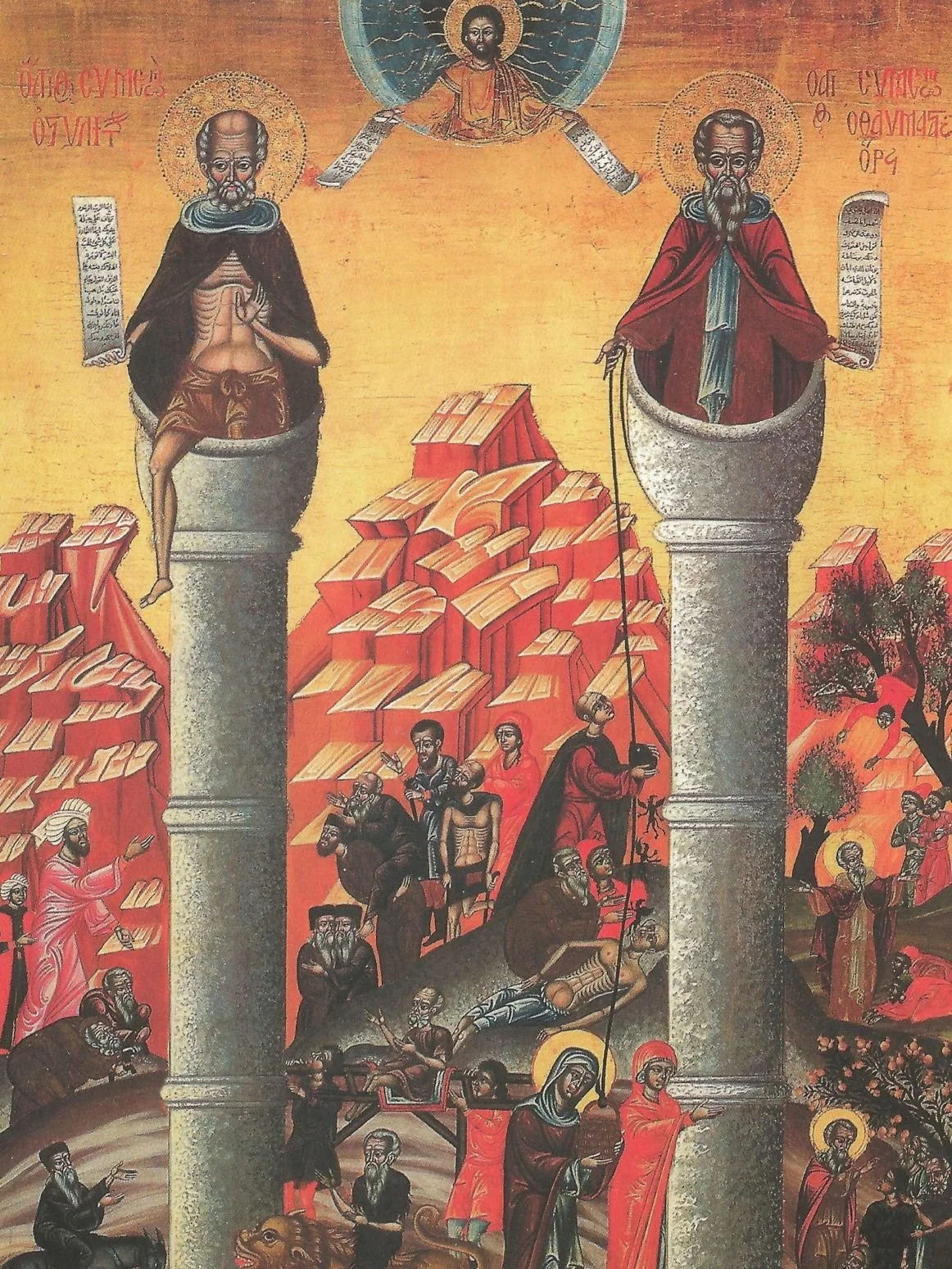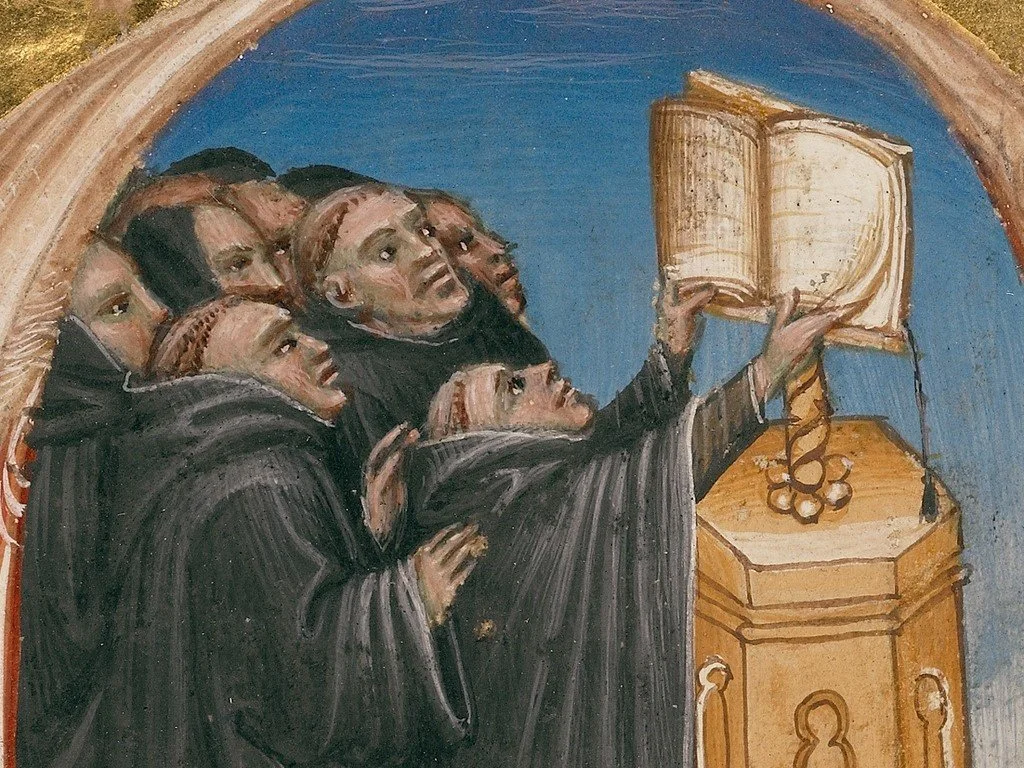Medieval Monks Rock Around The Clock
Monks in a monastery, all singing and chanting in Latin is one of the most enduring images of the medieval world.
Likely, you’ve already got a picture in your head. You can imagine monks copying texts in the scriptorium. Also, you picture a monk with a giant tankard of beer. And you definitely imagine them with their sweet tonsure haircuts. For many people, medieval = monks.
How did that happen? As with everything else, this quintessentially medieval institution developed gradually and then continued to evolve over the next 1,000+ years.
The first monks started to pop up after the Roman Empire became Christian. Now that Christianity was the dominant faith, some people wanted to show their piety by living an ascetic life.
Most early monks went solo, heading out into the desert or living on top of a pillar, hoping to get away from everyone to get closer to the divine. Paradoxically, these loners attracted followers, and soon enough, monks started living together in communities apart from the rest of society.
In the early days, there was no set way for monks to be monks. In the early 500s, Saint Benedict of Nursia wrote down the rules that worked for his monastery, and these would become the standard across Europe by the year 900 or so.
Benedictine monasticism was hierarchical and stressed unity of belief. The abbot was the leader of the monks, and all had to obey him. The abbess was the leader of the nuns, and all had to obey her. Obeying was important. Everyone had their role, and there was a lot to do.
Daily life was rigorous and adhered to a strict schedule that divided time between work, prayer, and more work and more prayer. Monks started the day with prayer, and then returned to the sanctuary to pray, sing, and chant at specific hours:
“Matins, Laud, Prime, Tierce, Sext, Nones, Vespers, Compline, and Nocturne”
You had to wake up in the middle of the night to sing nocturne. If you fell asleep, don’t worry, another monk was assigned to wake you up so you could rejoin the song.
In between prayer times, there was work to do. Monks would do manual labor and more elevated tasks, like copying manuscripts in the scriptorium. Oh, and it’s best if you don’t talk and don’t eat too much even if you’re hungry. All day, every day. Rinse, repeat.
This sounds like a hard job, right? Who would sign up for this program? Well, lots of people. Monastic life attracted a variety of types of adherents:
- Those called to a spiritual life would find it in prayer, fellowship, and contemplation.
- Intellectually inclined peasants could stimulate their minds with books and scholarship.
- Elderly rich people could retire in relative comfort, after making a generous donation.
- Parents could donate their children as “oblates” who would then grow up to be monks.
- Younger sons of nobles could not inherit the family land, but they could be made abbots.
While the ascetic life denied its adherents many pleasures and conveniences, it offered community, safety, and stability in a chaotic world. You knew your place and were secure in it.
Monasteries were rural centers of power and significance for the clergy, generally away from towns and castles. Bishops were usually in cities and enmeshed in the medieval power structure and often involved in shenanigans with kings, dukes, and counts.
Monasteries were an important feature of the medieval world. They weren’t completely left alone by the secular authorities, but they did make space for learning and scholarship unlike anywhere else in the medieval world.
Without medieval monks laboriously copying ancient texts, the modern world would know almost nothing about the ancient world. So give your thanks to the monks of yesteryear and try not to make fun of their haircuts too much.
Why do people join your organization? Is it your top reputation in your industry? Were you ranked “top workplace” in your industry or geography? Maybe you have an awesome dental plan?
Some join with a plan to grow their career for decades. Others think shorter term, just a year or two ahead. Entry level workers usually have different priorities than seasoned players. Some might seek stability; others might find stability stifling.
Just as medieval people became monks and lived in monasteries for various reasons, there’s no one right answer for how to attract new recruits. You must appeal to different people in different ways. But there must be something that appeals to each of the groups you want to attract.
What keeps people at a company is often very different from what attracts them to join somewhere new. A positive culture and community that makes people feel valued matters most once you’re in a job, but a higher salary can tempt anyone to at least talk to the recruiter.
If you leave for a higher salary and then end up hating your new job, well, that’s one of those lessons you just might have to learn the hard way. Just hope your new boss won’t wake you up in the middle of the night to sing with the choir.
If you think the highly-regimented lifestyle of a monk might be for you, you might want to check out How to Live Like a Monk: Medieval Wisdom for Modern Life by Daniele Cybulskie. There are a lot of things they did back then that you can incorporate into your work routine today to get the important stuff done and handle stress better.
This approach to working worked for hundreds of years before email existed, so maybe it might work for you if you’re struggling with your overflowing inbox. Just check with your boss first before you show up to your next team meeting with a tankard full of beer.






